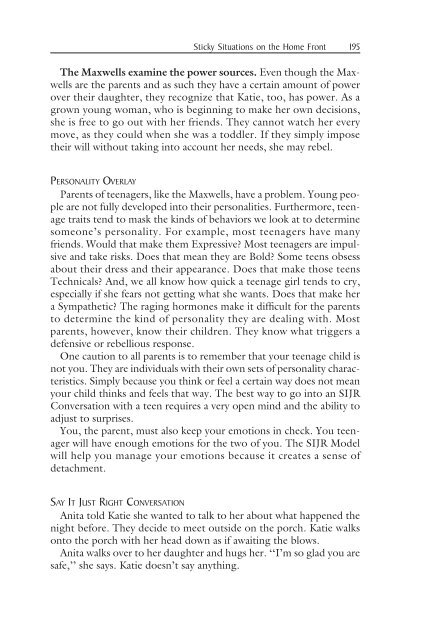Managing Sticky Situations at Work
Managing Sticky Situations at Work
Managing Sticky Situations at Work
You also want an ePaper? Increase the reach of your titles
YUMPU automatically turns print PDFs into web optimized ePapers that Google loves.
<strong>Sticky</strong> <strong>Situ<strong>at</strong>ions</strong> on the Home Front 195The Maxwells examine the power sources. Even though the Maxwellsare the parents and as such they have a certain amount of powerover their daughter, they recognize th<strong>at</strong> K<strong>at</strong>ie, too, has power. As agrown young woman, who is beginning to make her own decisions,she is free to go out with her friends. They cannot w<strong>at</strong>ch her everymove, as they could when she was a toddler. If they simply imposetheir will without taking into account her needs, she may rebel.PERSONALITY OVERLAYParents of teenagers, like the Maxwells, have a problem. Young peopleare not fully developed into their personalities. Furthermore, teenagetraits tend to mask the kinds of behaviors we look <strong>at</strong> to determinesomeone’s personality. For example, most teenagers have manyfriends. Would th<strong>at</strong> make them Expressive? Most teenagers are impulsiveand take risks. Does th<strong>at</strong> mean they are Bold? Some teens obsessabout their dress and their appearance. Does th<strong>at</strong> make those teensTechnicals? And, we all know how quick a teenage girl tends to cry,especially if she fears not getting wh<strong>at</strong> she wants. Does th<strong>at</strong> make hera Symp<strong>at</strong>hetic? The raging hormones make it difficult for the parentsto determine the kind of personality they are dealing with. Mostparents, however, know their children. They know wh<strong>at</strong> triggers adefensive or rebellious response.One caution to all parents is to remember th<strong>at</strong> your teenage child isnot you. They are individuals with their own sets of personality characteristics.Simply because you think or feel a certain way does not meanyour child thinks and feels th<strong>at</strong> way. The best way to go into an SIJRConvers<strong>at</strong>ion with a teen requires a very open mind and the ability toadjust to surprises.You, the parent, must also keep your emotions in check. You teenagerwill have enough emotions for the two of you. The SIJR Modelwill help you manage your emotions because it cre<strong>at</strong>es a sense ofdetachment.SAY IT JUST RIGHT CONVERSATIONAnita told K<strong>at</strong>ie she wanted to talk to her about wh<strong>at</strong> happened thenight before. They decide to meet outside on the porch. K<strong>at</strong>ie walksonto the porch with her head down as if awaiting the blows.Anita walks over to her daughter and hugs her. ‘‘I’m so glad you aresafe,’’ she says. K<strong>at</strong>ie doesn’t say anything.















